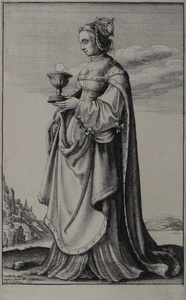| Method | Etching |
| Artist | Wenceslaus Hollar after Hans Holbein the Younger |
| Published | Holbein inv. WHollar fect ex Collectione Arundeliana, 1647 |
| Dimensions | Image 188 x 122 mm, Sheet 203 x 124 mm |
| Notes |
A full length female figure in left profile, wearing a low cut, ermine-trimmed overdress and a crown on top of her braided hair, and is holding up a chalice with wafer in her left hand. Behind her lays a lake, and a mountainous landscape with a castle. This print was made after the painting by Hans Holbein the Younger. Art historians have debated over whether this figure can be identified as Anne Boleyn, but strong links are also drawn between this image and a portrait of St Barbara on a stained glass window in the municipal museum in Bale. St Barbara is a legendary Christian virgin martyr, believed to have lived in the 3rd century in Asia Minor. Her father Dioscorus locked her up in a tower during her youth until he was ready to have her marry a rich suitor. Barbara however refused the marriage, as she had secretly learned about Christianity through her maidservants, and was converted. Her father was furious and eventually beheaded her with his own sword because she did not give up her faith. Barbara was a very popular saint, often portrayed with a tower in her hands, and was venerated as one of the fourteen auxiliary Saints. Due to the lack of written evidence of her existence, specifically in early Christian writings, she was dropped as an official saint in the 1960's. Anne Boleyn (c.1501 - 1536) was the second wife of King Henry VIII, and between 1533 and 1536, was the Queen of England. In her own right, she was Marquess of Pembroke. The only living child of Anne and Henry was the future Queen of England, Elizabeth I, which caused tension as Henry was desperate for a son. In 1536, Henry had Anne investigated for high treason, and in May, she was executed. Although Anne was charged with adultery, incest, and plotting to kill the king, historians recognise these as unconvincing. Wenceslaus Hollar (1607-1677) left his native Prague in 1627. He spent several years travelling and working in Germany before his patron, the Earl of Arundel brought him to London in 1636. During the civil wars, Hollar fought on the Royalist side, after which he spent the years 1644-52 in Antwerp. Hollar's views of London form an important record of the city before the Great Fire of 1666. He was prolific and engraved a wide range of subjects, producing nearly 2,800 prints, numerous watercolours and many drawings. Hans Holbein the Younger (1497-1543) was a painter, draughtsman and designer of woodcuts. He also worked with glass-paintings, metalwork, and jewellery. Holbein was born in Augsburg. He worked in Basel as a journeyman at the end of 1515, and was first employed there with Ambrosius by humanist scholars and their printers. In 1519, he was admitted to the painters' guild. With an introduction from Erasmus to Sir Thomas More, he left for England at the end of August 1526, and stayed for two years working in the court circle, before returning to Basel. He returned to England in 1532, and, under the patronage of Henry VIII, he produced a succession of magnificent portraits. The most famous of which was the mural painting glorifying the Tudor dynasty in the Whitehall Palace. It was regrettably destroyed in the fire of 1698. Pennington 176 i/i, Hollstein (German) i/i (Hollar) Condition: Trimmed close to image. Tipped unto album page. Minor overall time toning. Good impression with slight wear to the plate. |
| Framing | unmounted |
| Price | £400.00 |
| Stock ID | 47727 |

